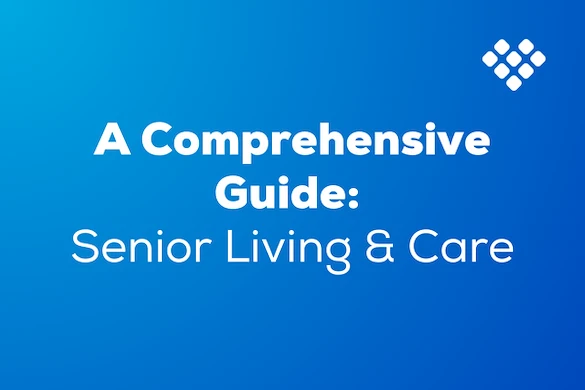Preparing for the Move: The Emotional Side of Senior Living
Moving into a senior living community is more than a physical change, it’s an emotional journey as well. It’s natural to feel a mix of anticipation, relief, worry, or even grief.

With the right mindset and support, this transition can also bring calm, confidence, and hope. This guide explores how to prepare emotionally for the move, so that when moving day comes, your heart feels as ready as your home.
Key Takeaways

Feeling emotional is normal. Acknowledging and expressing feelings helps you adjust.

Start small, stay involved. Taking gradual steps keeps the process from feeling overwhelming.

Connection matters. Staying in touch with loved ones eases loneliness and fear.

Focus on what’s ahead. Embrace the independence, safety, and community your new home offers.
Step 1: Acknowledge What You’re Feeling
Transitions often bring a wave of emotions such as sadness about leaving, guilt about “the decision,” or uncertainty about what comes next. Try to name those feelings rather than push them aside. You might be leaving a home filled with memories or saying goodbye to familiar routines.
Family members often struggle, too, feeling torn between wanting their loved one to be safe and worrying about how the change will be received. It can help to talk openly about what you’re experiencing. Write your thoughts in a journal, share them with family, or speak with a counselor, chaplain, or senior move manager who understands these transitions.
Remember, mixed emotions don’t mean you’re making the wrong choice, they mean you care deeply about your next step. Naming those feelings gives them less power and helps you move forward with clarity.
Step 2: Talk Openly as a Family
If you’re supporting a parent through this move, communication is key. It’s easy for emotions to run high when the subject of “the move” comes up, but the more open and collaborative the conversation, the smoother the process becomes.
Ask about their hopes, fears, and priorities. What matters most in their new home, proximity to family, a private patio, or a community with plenty of activities? Listening closely helps everyone feel respected and included. Families often find that honesty brings relief. When everyone has a chance to share their thoughts, the process feels more connected and less clinical. A shared laugh or a good cry can go a long way toward easing tension.
If discussions become stressful, consider bringing in a neutral third party such as a senior care advisor, counselor, or trusted clergy member to help guide communication. The goal isn’t perfection, it’s mutual understanding and peace of mind.
Watch: What Questions Should I Ask My Loved One Before Considering a Senior Living Community?
Step 3: Create Comfort in the Process
Emotional preparation starts long before moving day. Visit the community ahead of time, if possible. Attend an open house, join a meal, or walk the grounds together. These small, low-pressure visits can help the environment feel familiar and inviting.
At home, look for ways to keep the process meaningful rather than purely logistical. As you sort and pack, share stories tied to keepsakes: the family photo from your last vacation, the teacup set passed down through generations. Choose a few cherished items that bring comfort and continuity. Comfort isn’t about how much you take with you, it’s about surrounding yourself with reminders of love, identity, and belonging.
Many communities also offer pre-move programs or welcome ambassadors who can connect new residents with current ones before arrival. Knowing even one friendly face on day one can make a big emotional difference.
Step 4: Give Yourself Time to Adjust
Even the most positive moves take time to feel right. It’s common for the first few weeks to feel uncertain or lonely. The daily rhythms are new, and familiar comforts take time to rebuild. Set gentle expectations for yourself or your loved one. Adjustment happens gradually as routines form and new friendships grow. Celebrate small milestones: learning a neighbor’s name, joining a community meal, or feeling comfortable asking for help when needed.
For adult children, remember that your loved one’s adjustment won’t look identical to yours. It’s okay to step back after the move and give them space to settle in at their own pace. Check in often but avoid hovering; confidence grows from small moments of independence.
Step 5: Stay Connected After the Move
Connection is one of the strongest emotional supports in any life transition. Staying in touch, even in simple ways, helps ease homesickness and builds a sense of continuity. Family visits, quick phone calls, or video chats can make a world of difference. If distance makes visits hard, consider creative ways to stay involved like sending letters, sharing photos, or watching a favorite show together on video call.
Inside the community, early participation helps new residents feel more at home. Encourage joining a walking group, exercise class, or art activity. Even casual conversations over coffee can spark meaningful friendships.
Many senior living communities have social coordinators or “welcome committees” to help new residents find their footing. Taking advantage of those programs can transform the transition from intimidating to inviting.
Step 6: Focus on What’s Being Gained
It’s easy to focus on what’s changing — a beloved home, a familiar neighborhood — but this move also opens doors to greater support, safety, and freedom.
Senior living isn’t about giving something up; it’s about gaining peace of mind. Many residents find they have more independence than before — more time to pursue hobbies, connect with others, and enjoy life without the burdens of home maintenance or isolation.
When doubts arise, revisit the “why” behind the decision: greater safety, reduced stress, better social connection, and a community that’s ready to help when needed. Shifting focus to what’s being gained helps create emotional balance and optimism.
<<How to Maintain Independence While Living in a Senior Community (in works)>>
Conclusion
Moving to senior living is a big emotional shift and it’s okay to feel every part of it. What matters most is taking time to prepare your heart as carefully as you prepare your home.
With compassion, connection, and patience, this transition can become a new beginning filled with purpose and peace.
If you’re just starting to explore your options, on Senior Care Finder you can find trusted communities near you, complete with verified details, reviews, and photos.




